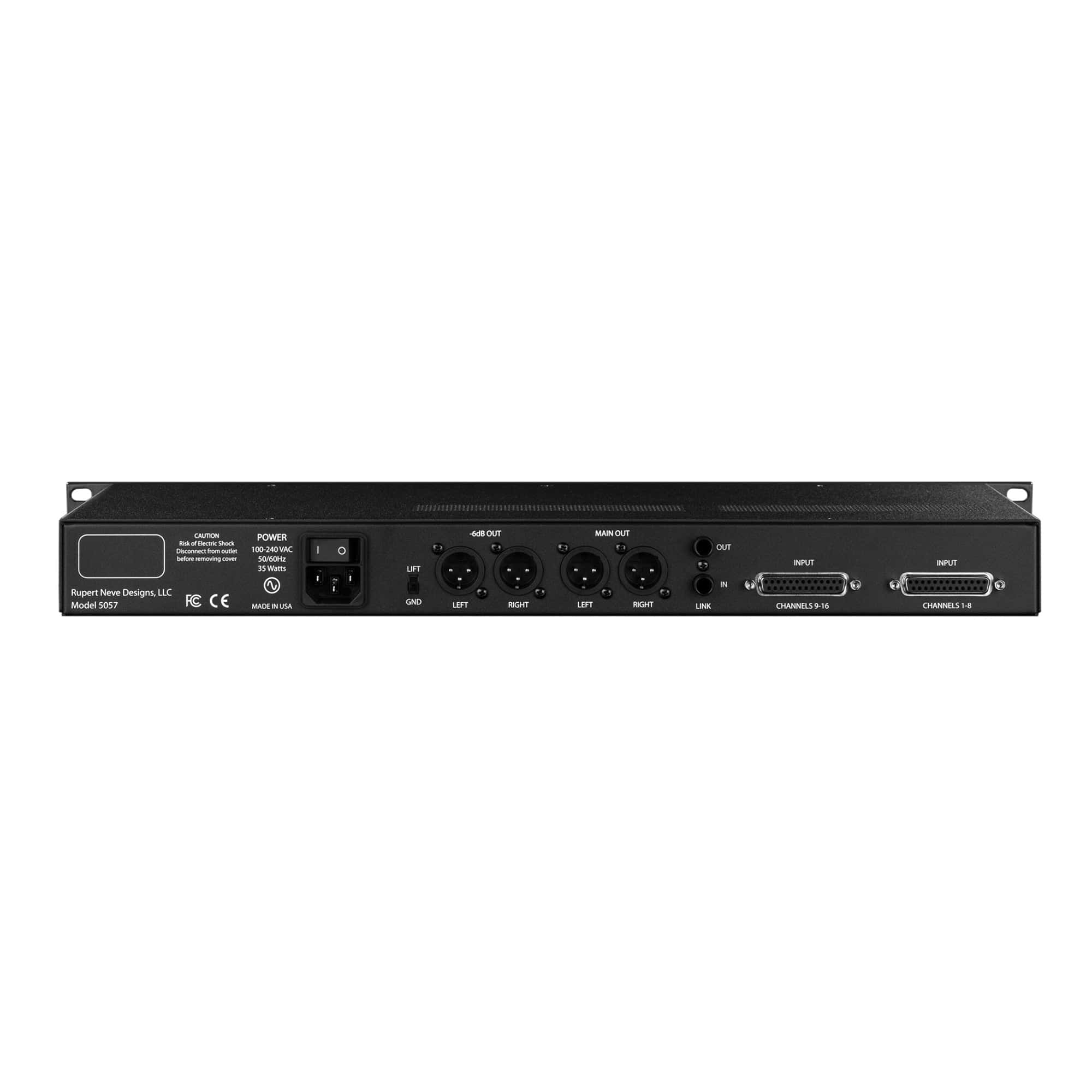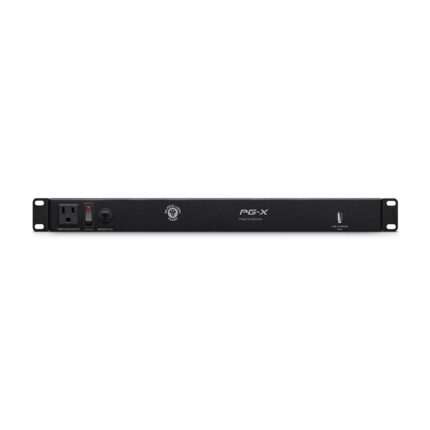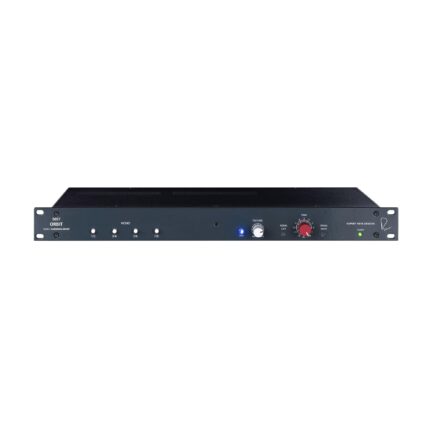| Content | Firmly rooted in six decades of console design experience, the 5057 Orbit gives your mixes the legendary tonality, power, and wide-open soundstage that only Rupert Neve’s class-A analog summing can provide. Coupled with Rupert’s famous custom audio transformers and Silk Red & Blue circuitry for variable harmonic saturation, the Orbit launches sterile in-the-box mixes to new heights of tone, depth and clarity – without compromising the recallable convenience and repeatability of your DAW-based workflow.
When you push a mix buss and output transformers towards saturation, the non-linear, musical harmonics that occur are what truly glue a recording together and bring it to life.
Rather than using an external summing solution that offers little more than an ultra-clean representation of the in-the-box experience, the Orbit provides the extraordinary richness, harmonic complexity and depth that only a Rupert Neve console can bring to your mixes.
The Orbit utilizes a highly custom output transformer configuration originally developed for the acclaimed Shelford Channel, which provides both a Main Output and a -6dB Output – the latter of which enables you to fully drive the Orbit to achieve more transformer harmonics without clipping the next device in the chain. This unique transformer drive is a hallmark of the sound of Rupert Neve throughout the years – and the sound of countless classic hit records.
Classic Sounds on Demand
Every mix demands its own treatment. In addition to the choice of outputs, the continuously variable Texture control with Silk Red and Silk Blue modes gives you complete control over the harmonic density and tonality of your mix – or lets you keep it utterly pristine and uncolored.
The Silk Red mode accentuates transformer saturation in the high and high-mid frequencies to amplify the vibrant midrange harmonics associated with Rupert’s vintage equipment, while Silk Blue accentuates saturation of the lows and low-mids to add thickness and weight to any source – especially useful for “thin-sounding” mixes. Unlike EQ, these Silk & Texture controls saturate the output transformers, and add highly musical harmonics to the source material according to the amount of Texture applied.
Drive the mix buss hard, choose your Silk flavor, and crank the Texture knob for a rich, saturated, vintage vibe – or disengage Silk entirely for clear, wide-open sonic beauty. The choice is yours.
Build your Dream
While the Orbit is an extremely effective tool on its own, multiple units can be combined through the Buss Link for a higher channel count. The 5057 Orbit can also be used as a building block in an expandable summing system utilizing the 5059 Satellite for flexible summing & routing, and the 5060 Centerpiece for additional mixing and monitoring features.
These units create the core of a world-class analog modular console system rivaling any traditional large-scale studio setup.
Channel Separation and Accuracy
With precisely fixed channel levels and accurate mix buss attenuation via high-quality stepped switching, the Orbit’s purist signal path has vanishingly low crosstalk, and channels matched to within +/-0.1dB. This provides your mixes with the widest and most accurate stereo image, the greatest depth, and the most direct signal path, allowing you to hear every single detail of your mixes.
DAW Based Recall without Compromise
Frequent recalls can be a challenge for modern mix engineers. The Orbit’s elegant simplicity and fixed level accuracy provides rapid, repeatable DAW-based recall from mix to mix, while adding the rich, unrivaled sound quality of Mr. Neve’s class-A transformer-coupled mix buss.
INPUT IMPEDANCE
16K Ohm
FREQUENCY RESPONSE
- 10 Hz to 50 kHz: +/- 0.1 dB
- 150 kHz: -3 dB
NOISE
- From 22 Hz - 22 kHz.
- -90 dBu typical
MAXIMUM INPUT LEVEL
@ 1 kHz: +26 dBu
MAXIMUM OUTPUT LEVEL
@ 1 kHz: +26 dBu
THD+N%
- From 22 Hz - 22 kHz.
- 0 dBu @ 1 kHz: 0.003%
- +20 dBu @ 1 kHz: 0.0006%
CROSSTALK
- 1 kHz: -103 dBu
- 10 kHz: -93 dBu
PRODUCT DIMENSIONS
19” W (48.3 cm) x 9” D (22.9 cm) x 1.75” H (4.4 cm)
SHIPPING DIMENSIONS
24” L (61 cm) x 13” W (33 cm) x 4” H (10.2 cm)
SHIPPING WEIGHT
10 lbs (4.5 kg) | With a big, bold preamp, a swept high-pass filter and the powerful saturation control of variable Silk, the 511 combines legendary Rupert Neve tone with 500 Series value.
What is Silk?
One of the key features of the 511 is the Silk / Texture control. The Silk circuit was initially developed for the original Portico series mic preamplifiers, and was only a single switch – on or off – that added a specified amount of musical, pleasing harmonic saturation to the unit’s output stage.
Taking this concept one step further, the Texture knob is designed to adjust the actual amount of harmonic content from the source material.
So how does it work? By reducing negative feedback across the output transformer and adjusting this feedback’s frequency response, the Silk / Texture circuit provides the sweet, musical saturation found in Rupert’s legendary vintage designs – but with complete & precise control over the amount of classic tone you want.
NOISE
- Measured at Main Output, un-weighted, 22 Hz - 22 kHz, source impedance 150 Ohm balanced. Noise performance can vary depending on the 500 series and / or interference from stray magnetic fields.
- Unity Gain: Better than -103 dBV
- Gain @ +66 dB: Better than -60 dBV
- Equivalent Input Noise: -125 dB
FREQUENCY RESPONSE
- Main output, no load.
- +/- 0.1 dBu from 10 Hz to 31.5 kHz
- -2.6 dB @ 120 kHz
MAXIMUM OUTPUT LEVEL
+23 dBu
TOTAL HARMONIC DISTORTION AND NOISE, NO SILK
- @ 1 kHz, +20 dBu output level, no load: Better than 0.0025%
- @ 20 Hz, +20 dBu output level, no load: 0.025% Typical (2nd and 3rd harmonic)
TOTAL HARMONIC DISTORTION AND NOISE WITH SILK ENGAGED
- @ 100 Hz, +20 dBu input level, no load.
- TEXTURE @ min: 0.015%, mostly 3rd harmonic typical
- TEXTURE @ max: 2%, mostly 2rd harmonic typical
GAIN
- Unity up to +66 dB in 6 dB steps.
- Trim continuously adjustable from -6 dB to +6 dB.
PHANTOM POWER
Supplied by the 500 series rack power supply. Switch selectable on faceplate.
HIGH PASS FILTER
- Continuously variable swept frequency from 20 Hz to 250 Hz.
- Slope: 12 dB/Octave
POWER REQUIREMENTS
@ +/-16VDC, 100mA | This item is in excellent working condition and barely used.
The ZHA-4 splits a single stereo headphone output into four separate powered 1/8” headphone jacks, each with their own volume and mute control. Perfect for bands, podcasts, productions, and more.
Two AA batteries provide hours of portable power. For longer sessions, connect the USB-C port to a portable battery or plug directly into the wall.
What’s in the Box?
- ZHA-4 Handy Headphone Amplifier
- AA Batteries (x2)
- Stereo Mini Audio Cable (19” / 50cm)
- Quick Guide
Please Note: The item displayed in the images may not be the actual item you receive. | Proven reverberation classic for the future
With the VSR 3.2, we happily rely on the proven old mechanical way to create reverberation. Rightly, because the used reverberation spring by AccuBell (formerly Accutronics) creates that magic 60's reverb which is slightly metallic and dense at the same time.
Just like it predecessors, VSR 3.2 has a straight-forward and honest approach: signal in - spring reverb - vintage sound out.
VSR 3.2 is equipped with an equalizer that is exactly adapted to the springs' frequency response. In addition, there are controls to mix the dry and effect signal as well as controls for the input and output level. This way, VSR 3.2 simply exactly does what it was designed to do.
Designed for every situation
Although using a large spring (type 9), VSR 3.2 fits in a 19" housing with one rack unit – minimal space requirements. Thanks to its extremely solid chassis, VSR 3.2 is a reliable vintage-effect that cannot only be used in a controlled studio environment. On the contrary, it also serves fine when being used in straining live situations.
VSR 3.2 grants your sound an elegant touch of "good old times". Its simplicity makes it an unbelievable versatile companion.
Inputs
- 1/4"-jack input front
- unbalanced
- max. input sensitivity: –40 dBu
- impedance: 1 MΩ
- 1/4"-jack input rear (1)
- unbalanced
- max. input sensitivity: 0 dBu
- impedance: 100 kΩ
- 1/4"-jack input rear (2)
- unbalanced
- max. input sensitivity: –20 dBu
- impedance: 10 kΩ
Outputs
- 1/4"-jack output (1)
- unbalanced
- max. output level: 0 dBu
- 1/4"-jack output (2)
- unbalanced
- max. output level: - 20 dBu
Signal-to-Noise Ratio
- direct: > 80 dBu
- effect: > 70 dBu
THD + Noise
Miscellaneous
- power supply: external DC-adapter with 12 V/1000 mA
- dimensions: 19“, 1 HE, ca. 190 mm deep
- weight: 2.5 kg
| The Suhr Reactive Load delivers a simple solution to capture all of the warmth, and dynamics of your sound, without the hassle of miking a speaker cabinet during a live or recorded performance.
The Reactive Load takes the place of your speaker cabinet in your signal chain. It provides an 8Ω load for your tube amplifier (maximum 100 watts), and produces a balanced and unbalanced signal that interfaces with recording devices, effects, and power amplifiers.
The Suhr Reactive Load is the perfect link between your amplifier and computer audio recording interface. You can use the Reactive Load with your existing library of speaker impulse responses (IR) for the most realistic direct recording experience possible.
Traditional resistive load boxes will safely load your amplifier, but they also alter the tone, dynamics, and response of your amplifier. Real speakers do not have a fixed resistance across the entire frequency spectrum. Real speakers are reactive.
The impedance curve of the Reactive Load has been painstakingly tuned to react like a speaker. Your amp will never know the difference.
The Reactive Load is dedicated to being the absolute best load box possible with zero compromises, and therefore does not include speaker emulation. You can use the Reactive Load with your speaker-sim or impulse response of choice, and benefit from the natural response, dynamics, and touch sensitivity of your amp.
The Suhr Reactive Load features a balanced or unbalanced line level output. The INPUT is optimized for the 8 ohm output of your amplifier and the THRU jack can be connected to a physical speaker cabinet. If a physical cabinet is connected to the THRU jack, the Reactive Load’s internal load is bypassed and the amp will see the load of the physical cabinet.
SPEAKER INPUT IMPEDANCE: 8 Ohm
DI / LINE OUT LEVEL: +4 dBu at 7 watts input, maximum level setting
BALANCED LINE OUTPUT IMPEDANCE: Less than 6KΩ
UNBALANCED LINE OUTPUT IMPEDANCE: Less than 6KΩ
MAXIMUM RECOMMENDED INPUT POWER: 100 Watts RMS
ROHS COMPLIANT: Yes
DIMENSIONS: 8.8" (W) x 8.9" (D) x 3.6" (H)
WEIGHT: 6.6lb | Originally developed for the dynamics circuit of the acclaimed Shelford Channel, the 535 Diode Bridge Compressor captures the soul of Rupert Neve’s original 2254 compressor while providing modern updates including advanced timing control, significantly lower noise, fully stepped controls throughout, and internal parallel processing capabilities.
What is diode bridge compression?
Where the VCA compressor found in the Master Buss Processor provides unmatched clarity, the weighty, harmonically rich tonality of diode bridge compression can be essential in pushing key sources like vocals, electric guitars, bass and drums to the forefront of a mix.
By understanding the limitations of vintage units like the legendary 2254, painstaking effort was taken to reproduce the unique tone of these classics while improving the noise floor & accuracy, expanding inflexible time constants, adding full wave sidechain detection for improved dynamic response, and widening the range of threshold and ratio controls.
Delivering the powerful sound of these iconic designs with enhanced flexibility for the modern age, the 535 Diode Bridge Compressor is a dynamic tool equipped to make a bold statement on virtually any mix or track.
LINE INPUT TO LINE OUTPUT
- Compressor Bypassed.
- Z source = 40 Ohm Balanced
INPUT IMPEDANCE
10K Ohm
OUTPUT IMPEDANCE
40 Ohm
MAXIMUM INPUT LEVEL
+23.5 dBu
MAXIMUM OUTPUT LEVEL
+23.5 dBu
NOISE
- 22 Hz - 22 kHz BW.
- -101 dBu
FREQUENCY RESPONSE
- 10 Hz - 120 kHz, 30ft Output XLR Cable.
- +/- 0.25 dB
THD+N
- @ 1 kHz @ Maximum Output Level, 22 Hz - 22 kHz BW.
- 0.001%
|


















Reviews
There are no reviews yet.